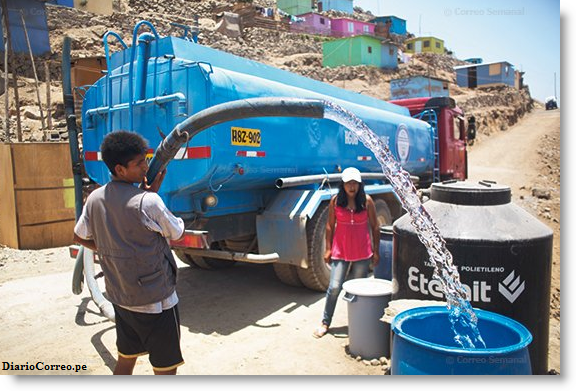 By Jonas Jägermeyr — The Mark News —
By Jonas Jägermeyr — The Mark News —
Everybody depends on it, there is no substitute if we run out, and it might be even more valuable than oil; yes, it’s freshwater.
The growing water scarcity as a result of rising human demands and a changing climate increasingly undermines global food security and ecosystem sustainability alike. This twin challenge is at the heart of the United Nations’ Sustainable Development Goals (SDGs), committing all countries to bold and transformative action by 2030.
Each person needs 20–50 liters of clean water each day for drinking and hygiene. Freshwater is at the very core of human development – it is inextricably linked to food security, economic growth and poverty reduction. So why isn’t water scarcity subject to bigger debate?
__________________________________________
Sustainable freshwater management is key to world food security. But much of water’s potential is not being fully realized because of inefficient irrigation methods or through natural processes, such as evaporation. A growing body of science and technology is addressing this – all that’s required now is a political will to get it done.
______________________________________________
At face value, little is known about how to provide the massive amounts of water needed to safeguard the environment and simultaneously double agricultural productivity. Indeed, smart water use, or optimizing our use of rain water and irrigation, can boost agricultural production, while preserving local ecosystems.
Even more recently, scientific advances in dynamic mechanistic modeling have allowed for detailed assessments of farm water management across regions, highlighting previously underestimated potential in water management. This suggests that related measures of high-level development strategies deserve more focus.
Global freshwater resources are both scarce and unevenly distributed between populations, resulting in many inequalities.
Between 1960 and 2005, the percentage of the world’s population under chronic water stress quadrupled. Climate change alters rain patterns and thus further worsens regional water scarcity and recurring droughts. Together, these realities put renewable water resources under heavy strain.
The current over-exploitation of freshwater is the No. 1 reason for the rapid degradation of worldwide ecosystems: groundwater tables are declining; a quarter of the world’s major rivers no longer reach the ocean; and more than half of all wetlands have disappeared. As a result, soil salinization and water pollution impair agricultural production and profit while unreliable supply levels jeopardize regional food security.
Irrigation is a cornerstone of feeding the world, but often comes at the price of excessive, leaky and inefficient water use. On average, about 50 percent of irrigation water is lost in conveyance and application; effective drip irrigation systems are operated on only about three percent of irrigated farmland. In many cases, water consumption used to produce food can be reduced easily and substantially by higher-efficiency systems.
Yet, realizing how to better save water supplies in favor of maintaining ecosystems and improving yields requires effective water legislations. Such rules, however, are widely missing, leading to a somewhat gridlocked and unfocussed debate on saving potentials.
But there is also huge potential to improve rainwater management – the largest untapped opportunity to tackle the water-food security challenge. Often, it is not the total amount of water, but the unreliable and erratic rainfall that poses the greatest problem for farmers, who produce more than 50 percent of the world’s food. Water harvesting, for instance, is an effective traditional, yet widely underexplored technique to collect and store excess rainwater for crops during dry spells.
In addition, conservation tillage systems and mulching – crop residues or plastic films covering the soil surface – help alleviate evaporation and make more soil moisture accessible to the crops. In semi-arid areas, such interventions can sustainably double crop yields, strengthen climate resilience and improve livelihoods of the working poor. While such methods are sporadically applied –in the African Sahel, for example – there is huge potential to scale up, particularly in regions where both population and food demand is growing fastest.
New scientific studies based on the most advanced global modeling techniques now suggest that the global potential of increasing water productivity is larger than expected.
Agricultural systems vary across watersheds and cultures. The net potential of farm water management has been difficult to quantify and still often gets a raw deal in political debates. Yet, a policy shift is needed to integrate water and food in the same political sphere. Specific strategies have to come to focus as implementation poses grand institutional challenges and requires non-marginal investments and locally refined solutions.
There is enough freshwater on the planet – water scarcity is a societal phenomenon – but sustainable food security for all appears beyond reach without a profound revolution in how we manage our water resources.
 During his doctoral studies at the Potsdam Institute for Climate Impact Research (PIK), Jonas Jägermeyr advanced global mechanistic modeling of water-food-environment interactions to study opportunities in farm water management in the context of water scarcity, food security, climate change, and Sustainable Development Goals. A geographer by training, he also conducted research at the NASA Ames Research Center, CA and Humboldt University of Berlin.
During his doctoral studies at the Potsdam Institute for Climate Impact Research (PIK), Jonas Jägermeyr advanced global mechanistic modeling of water-food-environment interactions to study opportunities in farm water management in the context of water scarcity, food security, climate change, and Sustainable Development Goals. A geographer by training, he also conducted research at the NASA Ames Research Center, CA and Humboldt University of Berlin.





